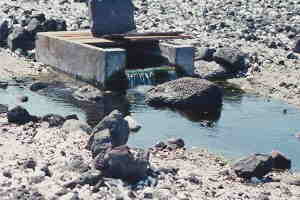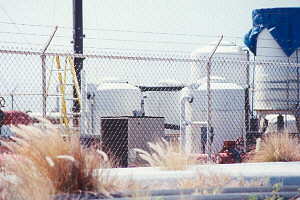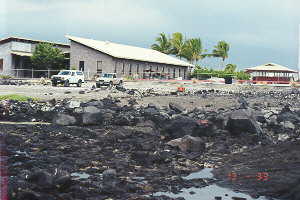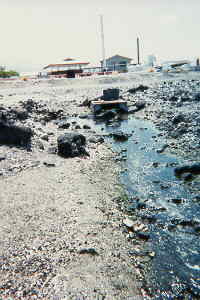| Fishermen and other Members of the Public Exposed to Toxic
Chemical at Keahole Point, Kona, Hawai’i |
 |
| On September 13, 1998, an unknown quantity of the chemical Dichlorofluoroethane (CCI2FCH3) or Genetron 141b was spilled into state waters at Keahole Point, Kona, Hawai’i. The source of the spill is located on land leased from the State of Hawai’i by the Natural Energy Laboratory Hawai’i Authority NELHA. | |
| Reportedly the chemical is being used in a desalination project conducted for the Bureau of Reclamation by Thermal Energy Storage, Inc. However, the Bureau of Reclamation claims they ended the project last May. |  |
According to the project summary, the results were not what they expected, and there were a number of unresolved problems with the chemical damaging the plastic pipes and joints used to cycle water. In a letter to EnviroWatch, Inc., dated September 30, 1998, the Bureau of Reclamation emphatically states their "agreement was effective on September 26, 1995 and was to continue 2 years beyond that date. The contract was extended until May 1998, at which time a final technical report was issued and the contract officially terminated. After that date, the Bureau of Reclamation was not involved in any work being conducted by Thermal Energy Storage, Inc.
 |
The spill was originally discovered on September 13th by fishermen and other citizens who were using an area adjacent to the spill site. They were not advised by NELHA or it’s tenants that the substance is toxic and harmful to human health, so they continued to use the area and came in contact with the substance.
| As recent as September 15th the US Coast Guard and other
federal and state agencies responsible for regulatory, enforcement and public health
concerns advised EnviroWatch Inc. that the spill had not been reported to their agencies,
an action that is required of any party responsible for a spill. In television and newspaper interviews Mr. James Frasier, NELHA’S Executive Director, denied that his facility is contaminating the environment, yet a variety of marine life was observed dead in the tide pools where the spill occurred. |
 |
In a letter from NELHA, to Mr. Dave Sommers, Department of Land and Natural Resources, dated September 14, 1998, Mr. Thomas H. Daniel, Ph.D, states:
"We appreciate the courteous way that you pointed out and helped us track down an apparent leak or spill of the clathrate form R141B from the desalination project being conducted here for the Bureau of Reclamation by Thermal Energy Storage, Inc."
EnviroWatch, Inc. telephoned Allied Signal, the manufacturer of the chemical, and spoke with Dr. J. Billmaier. Dr. Billmaier told us that they really didn’t know how this particular chemical would impact marine life because it was not intended to be used in a marine environment.
It is a requirement that NELHA maintain Material Safety Data Sheets for toxic chemicals they are using. The data sheet for dichlorofluoroethane clearly identifies a number of potential health hazards. For inhalation it is stated that "Over exposure to vapor may cause dizziness, loss of concentration and irritation. With high levels, effects can include central nervous system(CNS) depression (intoxication) and cardiac arrhythmia. Product vapors displace air and can cause suffocation especially in confined spaces".
Arguably this cites the worse case scenario, but, given the fact that NELHA failed to detect or report the spill, and their claim that the chemical is harmful to fish but not humans, should give cause for a closer look at the activities at NELHA’s facility.
Over the past year EnviroWatch Inc. has brought to the attention of Governor Cayatano and the Department of Land and Natural Resources several other activities occurring at NELHA’s facility that are not in compliance with state and federal laws. We have only been ignored. (See our page on Ho'ona from January, 1998) These and other violations occurred under the watchful eye of Governor Cayatano's State Attorney General's office, which serves as NELHA's legal counsel. Senator Inouye has been a major supporter of NELHA, acquiring funds for research and development. We contacted his office and informed his staff that people were sick , but have not had a response.
This is a classic example of environmental injustice. Last year, at Punchbowl National Cemetary, someone spray-painted the headstones. In the City of Kailua citizens are up in arms because of sewage spills. But, at Ho'ona, Keahole, NELHA and it's tenants have destroyed Hawai'ian graves and poisoned Hawai'ian people and you can't get an FBI investigator or politician to say a word.
To quote Alena Kamakakama Kaiokekoa, in a letter of complaint to the Federal Department of Justice; "Ironically, an incident occured at Punchbowl National Cemetary where individuals vandalized grave tombstones by spray painting. State and Federal entities initiated an investigation to arrest and prosecute those responsible for such vile acts. As well as the above named entities, other Federal agencies responsible for the welfare of historical sites in this area, such as my family's graves, have discriminated against me and my concerns regarding burials which are Hawai'ian. At Punchbowl, where non-Hawaiians are also entombed, the burials are sacred and afford vigorous State and Federal protection."
Unless we make our voices heard, we believe that the incidents at Keahole Point and Ho'ona are encouraged, will continue, and will only stop when one of projects under NELHA's supervision gets out of hand, resulting in injury, loss of human life or serious environmental damage. If you want to help stamp out environmental injustice please contact:
| Governor Ben. J. Cayatano |
|
808-586-0034 808-586-0006 (fax) |
| Senator Dan Inouye |
|
202-224-3121 |
The introduction of any deleterious substance is illegal and should have been reported regardless of the quantity or it’s toxicity to humans, wildlife, or the environment. If anyone has come into contact with waters at Keahole Point, they should probably seek medical attention.